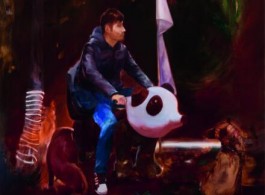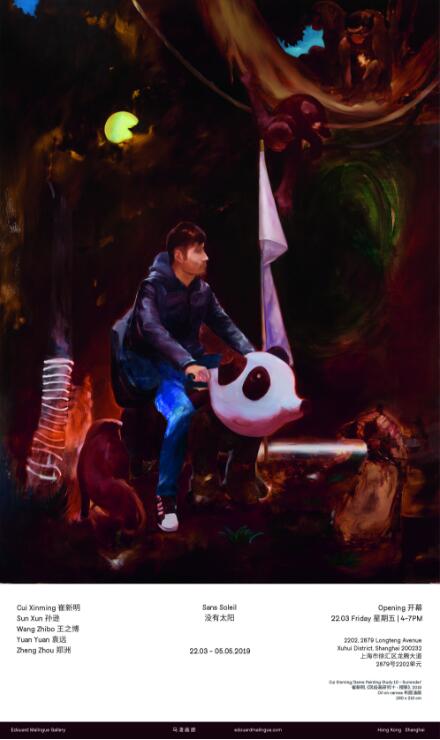Edouard Malingue Gallery
If the task of the classical painter is descriptive persuasion, by which nature could be represented in a picture with an almost immersive accuracy, the five contempo- rary painters presented in this exhibition take the opposite approach, achieving the illusion of nature by describing that which cannot be described but spells out the relations between man and the world. Varying in style and concept, the works on display – equally subjective and experimental in nature – testify to the vitality of the genre in their seeming lack of curatorial connection. Untethered from the shackles of technique and style, these artists permit subtle hints of criticism, met- aphor and eccentricity to grace their work, providing an articulation for a plethora of considerations.
Beyond a prolific painter across traditional ink, colour powder and woodcuts, Sun Xun is more often considered a film director. On display is an ink on silkscreen installation, replete with Sun’s signature ambiguity and phantasmagoria wherein intransigent conflicts and tensions fuse the line between deception and reality, scraping the uncontested surface of politicised truth. Sun’s art thus acts as a thea- tre of the power play between authority, government, media and, crucially, those outside of its periphery.
Zheng Zhou is a painter of instinct: straddling an epistemological outlet and what Zheng calls “the divine will” beyond technical, aesthetic and moral considerations, each painting acts as a canvased portal unto a segment of observations from the world. Presented is imagery of death and monstrosity conceived from The Legend of the White Snake, a Chinese romantic tragedy through which Zheng articulates tales of humanity, desire and fateful causality.
At a distance, Yuan Yuan’s elaborate oil on canvas paintings nearly resemble in their visual authority a photograph. His works, however, crucially do not represent reality per se. Rather, his protagonists – sumptuous yet depopulated interiors rang- ing between states of wealth and abandonment – are explorations of details, nar- rative threads rediscovered in the remembrance of things past. Charged by such sheer desire, or need to understand, Yuan’s paintings evoke the sensorial organisa- tion of the glitches or shifts between actualities: what could have been, could still be, or will eventually be. Akin to the process of tidying one’s household, they refer- ence the Düsseldorf School of Photography, in particular Candida Hfer, and French writer Alain Robbe-Grillet’s work, in the sense that finality is never fully achieved. One grasps that Yuan’s paintings are struck not with the sense of luxury and shock they appear to offer, but with the harmony between its subjective and objective actualities.
Marked by gestural vivacity, Cui Xinming’s phantasmal paintings resemble dis- placed news stories or film stills as if recalled from distant mnemonic incidents. Permeating Cui’s works is a pervasive sense of subjectivity and critique – a distinct pulse from Zheng and Yuan’s practice – augmented by a series of historical, social and art historical references. As such, Cui captures the spirit of an environment we are familiar with, but one that is under the undefined auspices of political and ideological flux.
There is this experience, when we stare long enough at an object and its form un- nervingly blurs. It represents the variances of our visual experiences when we ap- proach Wang Zhibo’s paintings, whose protagonists, upon closer examination, are never depicted quite as they are. The two still life paintings which capture two distinct moments in an anonymous kitchen, for instance, present a compositional practice through which Wang explores the meta-language of painting, whilst The history of body, the history of sprite (2019) experiments with, and challenges, mul- tiple manifolds of the body according to spatial, light and emotional variances.
Ultimately, ‘Sans Soleil’ is a pictorial travelogue, bringing together Edouard Ma- lingue Gallery’s five painters to weave a meditative visual essay that harks back to French writer and director Chris Marker’s seminal piece of the same title. Taking subjectivity and fiction as a departure point, as does Marker, one is left privy to the nature and nuances of contemporary painting and how, as a result, the perception of personal and collective histories is affected.




